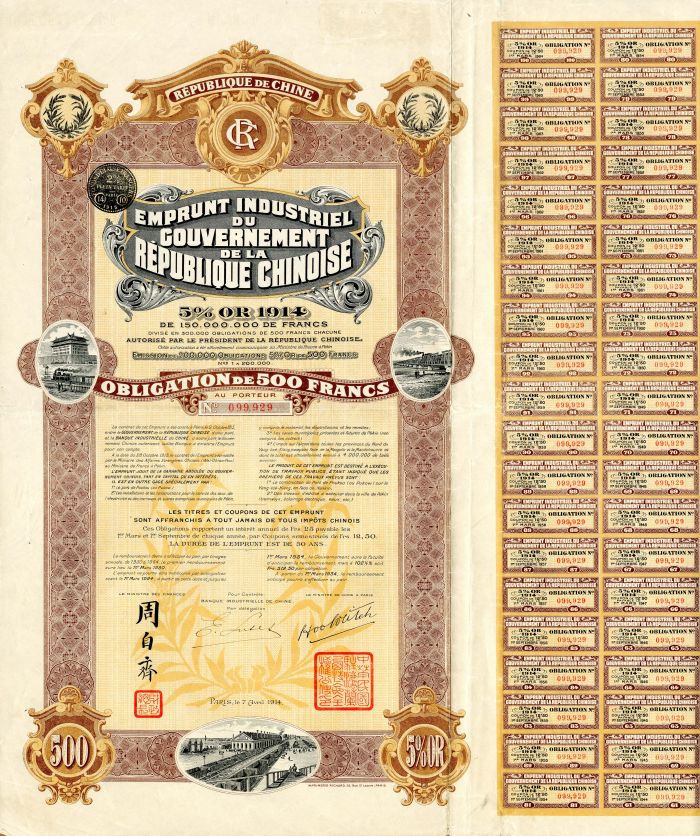Emprunt Industriel Du Gouvernement de la Republique Chinoise - 500 Francs Bond
Inv# FB6625 Bond
France
500 Francs, 5% Bond with coupons. Article relating to this Chinese item: https://www.bloomberg.com/news/articles/2019-08-29/trump-s-new-trade-war-weapon-might-just-be-antique-china-debt
The Republic of China (ROC), between 1912 and 1949, was a sovereign state recognised as the official designation of China when it was based on Mainland China, prior to the relocation of its central government to Taiwan as a result of the Chinese Civil War. At a population of 541 million in 1949, it was the world's most populous country. Covering 11.4 million square kilometres (4.4 million square miles), it consisted of 35 provinces, 1 special administrative region, 2 regions, 12 special municipalities, 14 leagues, and 4 special banners. The People's Republic of China (PRC), which rules mainland China today, considers ROC as a country that ceased to exist since 1949; thus, the history of ROC before 1949 is often referred to as Republican Era (simplified Chinese: 民国时期; traditional Chinese: 民國時期) of China. The ROC, now based in Taiwan, today considers itself a continuation of the country, thus referring to the period of its mainland governance as the Mainland Period (traditional Chinese: 大陸時期; simplified Chinese: 大陆时期) of the Republic of China in Taiwan.
The Republic was declared on 1 January 1912 after the Xinhai Revolution, which overthrew the Manchu-led Qing dynasty, the last imperial dynasty of China. On 12 February 1912, regent Empress Dowager Longyu signed the abdication decree on behalf of the Xuantong Emperor, ending several millennia of Chinese monarchical rule. Sun Yat-sen, the founder and its provisional president, served only briefly before handing over the presidency to Yuan Shikai, the leader of the Beiyang Army. Sun's party, the Kuomintang (KMT), then led by Song Jiaoren, won the parliamentary election held in December 1912. However, Song was assassinated on Yuan's orders shortly after and the Beiyang Army, led by Yuan, maintained full control of the Beiyang government, who then proclaimed the Empire of China in 1915 before abolishing the short-lived monarchy as a result of popular unrest. After Yuan's death in 1916, the authority of the Beiyang government was further weakened by a brief restoration of the Qing dynasty. The mostly powerless government led to a fracturing of the country as cliques in the Beiyang Army claimed individual autonomy and clashed with each other. So began the Warlord Era: a decade of decentralized power struggles and prolonged armed conflict. Read more at https://en.wikipedia.org/wiki/Republic_of_China_(1912%E2%80%931949)
A bond is a document of title for a loan. Bonds are issued, not only by businesses, but also by national, state or city governments, or other public bodies, or sometimes by individuals. Bonds are a loan to the company or other body. They are normally repayable within a stated period of time. Bonds earn interest at a fixed rate, which must usually be paid by the undertaking regardless of its financial results. A bondholder is a creditor of the undertaking.










Ebay ID: labarre_galleries